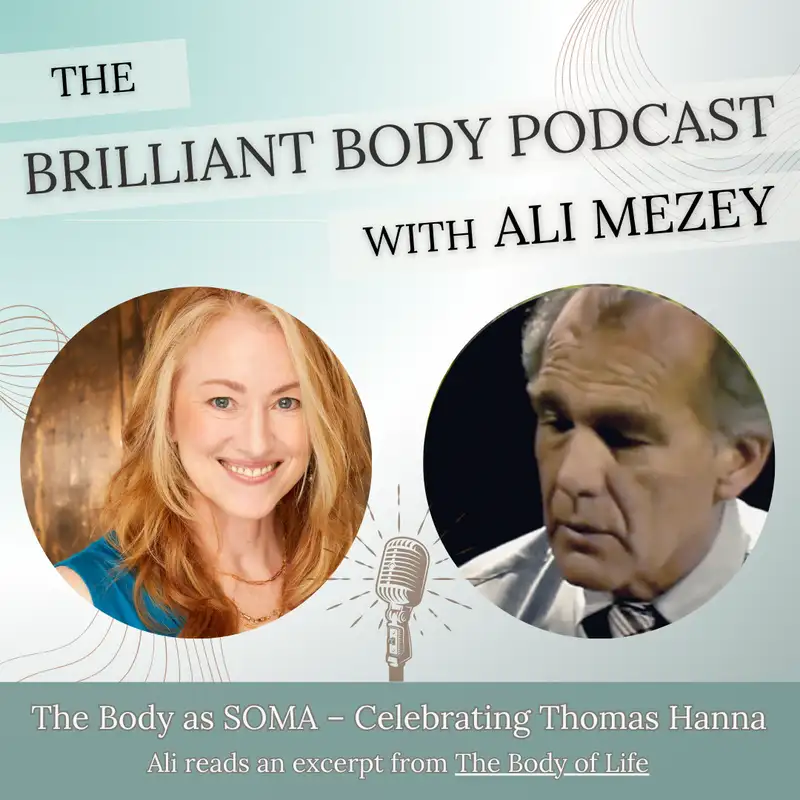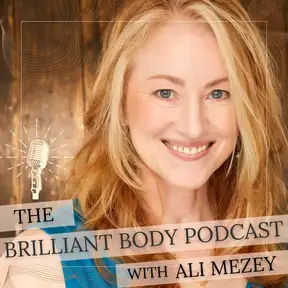The Body as SOMA: Ali reads an excerpt from Thomas Hanna's The Body of Life
In this episode, Ali Mezey share the concept of 'Soma' as illuminated by Master Bodyworker and Author, Thomas Hanna, in his book The Body of Life. Thomas Hanna coined the term 'somatic' now used extensively by practitioners of many body-based disciplines - he is one of the grandfathers of body therapy practiced all over the world in infinite variation. in this episode, Ali reads out of the introductory chapter which discussing the distinction between the physical body and the living, dynamic 'Soma' and dives into the broader context of human embodiment. Hanna's body of work, and this episode, offer a profound perspective on the interconnectedness, adaptability, and intrinsic intelligence of living systems.
To be an angel to the podcast, click here
To be an angel to the podcast, click here
MORE ALI MEZEY:
Website: www.alimezey.com
Personal Geometry® and the Magic of Mat Work Course information:
Transgenerational Healing Films: www.constellationarts.com
MORE THOMAS HANNA:
Website: www.somatics.org/about/introduction
More about: Who is Thomas Hanna in the world of Somatics?
To purchase Hanna's book: The Body of Life: Creating New Pathways for Sensory Awareness and Fluid Movement
More about: Who is Thomas Hanna in the world of Somatics?
To purchase Hanna's book: The Body of Life: Creating New Pathways for Sensory Awareness and Fluid Movement
Thomas Hanna Obituary
The bodywork community lost a vital member in Thomas Hanna, who died in a late July, 1990 auto accident near Novato, California. He was 61.
Born November 21, 1928, in Waco, Texas, Hanna was the founder of the Novato Institute for Somatic Research and Training in Novato, California and the editor of Somatics: Magazine-Journal of the Bodily Arts and Sciences. He also authored seven books, perhaps best know for Bodies in Revolt: A Primer in Somatic Thinking (1970) and Somatics (1989).
Hanna is survived by his wife, Eleanor Criswell, and three children, daughters Tad Hanna and Wendell Zitelman , and son Michael Hanna.
As an undergraduate at Texas Christian University from which he received a bachelor’s in 1949, Hanna initially thought about going into theology. He continued studies at the University of Chicago, later receiving a Bachelor of Divinity and then a doctorate in philosophy.
Hanna taught in Europe and several colleges throughout the U.S. At his memorial service held, Aug. 12, several people referred to his popularity as a teacher. One speaker recalled an incident while Hanna was teaching at the University of Florida. He was having car trouble and was going to be late getting to his class. He called his secretary as asked her to notify the class that he would be there but would arrive late. When he did arrive an hour and a half late, the class of 700 yoga students was still waiting for him in the ROTC quadrangle where the class met. Truly he was an engaging teacher. His commitment and involvement with his material, as well as his skill at communicating it, inspired his students.
In his early seminal books, he posed philosophical questions about humanity, i.e. what is it to be human, to be embodied, to be free? Those questions run like themes though his work. They were questions he never ceased exploring.
In the early 1970’s, after reading Bodies in Revolt, a well-known member of the bodywork world suggested he meet and study with Moshe Feldenkrais. As a result, Hanna studied with Feldenkrais in 1973 and 1974, and organized the first four-year Feldenkrais training program in the U.S. in 1975. He also founded the Novato Institute in 1975.
Hanna considered himself a writer, philosopher and teacher, not a bodyworker. He called the hands-on work Clinical Somatic Education. It was his strong belief that real change can only occur from within and not be imposed on someone from the outside. It is the difference between working on someone and working with someone. The goal was not to change tissue but to restore awareness and voluntary control over the sensory-motor system.
He believed that people were affected by a condition he termed sensory motor amnesia (SMA), and his work was designed to correct this. The concept of SMA is that if you lose your awareness of a part of your body, either through trauma or habituation, you lose your ability o move that part. Restoring awareness restores voluntary control. This can then be reinforced with simple movement patterns similar to Feldenkrais movement.
Hanna often referred to F.M. Alexander and Feldenkrais as important teachers for him. According to Hanna, Feldenkrais has made a tremendously important discovery about body function, but hadn’t fully explored the implications of that discovery himself. Hanna used the analogy that Feldenkrais had opened the door to a vast new territory, but had not gone inside to explore. Hanna had gone through the door and was exploring this new territory in light of recent development in neurophysiology, and the implications were breathtaking. Feldenkrais had said, and Hanna reiterated, that there is no limit what people can learn.
In an editorial last fall/winter, Hanna wrote about human mortality, analogizing it with his flowers:
“There was only one difference between the flowers and me: the impatiens affirmed the eternity of life, and I did not. The impatiens were pure in the way they lived, and I was sullied with contradiction…I realized that, all things considered, it was the impatiens who lived life to the fullest, whereas I was living my life, hamstrung. It was not I who was superior, but they…Is total affirmation of life and growth the highest good, or is it some kind of sinful ignorance? Should I live awaiting the end that I have envisaged, or should I live expecting only life and only future?
“Who is wiser? I, or the impatiens? I think the impatiens are wiser. They assume only what they know and feel. They do not assume something they do not know and feel…
“And so I water my impatiens this summer and into the autumn. And I gaze at their happy innocence. They are my teachers, just as my mother is my teacher. And the water sinks down into the soil, giving life. It is the same soil from which I sprang and my mother sprang. And it is the same soil that will receive us both.
“If I trusted it to give us life at the beginning, I might just as well trust it to give us life at the end. In that way, I have joined in a wisdom that tells me that my mother, my flowers, and I myself are now together and somehow will always be.”
- Victoria Carmona, a student of Hanna’s, contributed to this report.
From Massage, Nov/Dec. 1990, p.73.
MORE JANE PETERSON:
MORE JANE PETERSON:
To explore Jane's Family, Organizational or Couples Constellation Work trainings, go to her website: www.human-systems-institute.com
The Brilliant Body Podcast Episode 20: The Systemic Body: Navigating Relational Dynamics and Systemic Consciousness with Jane Peterson, PhD
The Brilliant Body Podcast Episode 20: The Systemic Body: Navigating Relational Dynamics and Systemic Consciousness with Jane Peterson, PhD
HELP US SHARE OUR MESSAGE
Our resources remain free as part of our mission to awaken people to the boundless potential of our bodies, inviting them to explore the profound knowledge, memory, and brilliance within. By delving into the depths of our bodily intelligence as a healing resource for not just ourselves, but as a part of the larger, global body, we have the potential for meaningful change and experience as bodies. Join us in this journey of transformation as we redefine our understanding of the human body and its infinite capabilities. While our events remain free, any contributions we deeply appreciate as a generous gesture of support and encouragement in sharing our, and our guests', messages with the world.
[From time to time, a word or phrase goes wonky. Please forgive my wandering wifi.]

